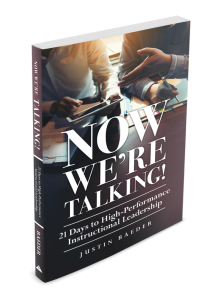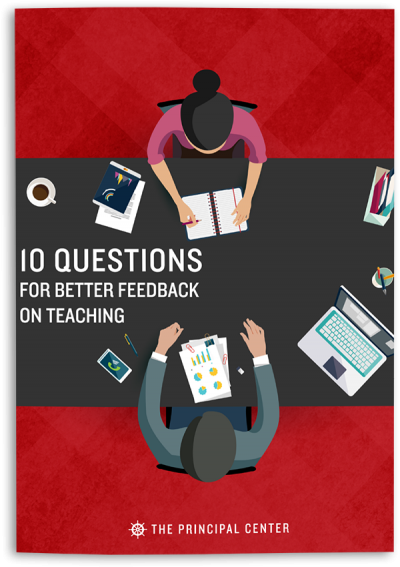Leading questions can ruin a feedback conversation fast.
Here's how to steer clear of them—and what to do instead.
by Justin Baeder, PhD

“So…how could you get students to listen better when you're giving instructions?”
A question like this may seem like a a gentler way to frame feedback, because it doesn't directly express a criticism like a blunt statement such as:
“Your students aren't listening when you're giving directions, because you aren't doing a good job of ensuring that they're listening.”
But our attempts to sidestep difficult feedback don't fool anyone. The sting is no less real.
Instead, the judgment is implied rather than communicated clearly.
When we try to imply our meaning rather than state it directly, we run the risk of confusing the teacher—in addition to causing hurt feelings.
Accidental Insults
Leading questions have the potential to insult teachers.
A classic and all-too-common example is the “Hey, why didn't you do X?” question.
If you see part of a lesson or unit, it's natural to have ideas that you didn't see the teacher implement:
“Hey, did you think about reviewing the vocabulary you pre-taught before starting on the shared reading?”
This is a leading question, and an unforced error, because it would be so easy to reframe it into an evidence-driven question that doesn't insult the teacher.
When we ask a leading question, we're implying that:
- The teacher DIDN'T think of doing what we're suggesting
- The teacher SHOULD HAVE thought of it
- They need to explain WHY they didn't
Instead, we can ask an evidence-driven question:
“So I noticed that you were doing a shared reading with some pretty difficult vocabulary today, and I know you've done some pre-teaching of that vocabulary. Talk to me about what you've done up to this point, and how that…”
Then, the teacher has a chance to tell you what happened before you observed, and how it affected the lesson you saw.
- Maybe they did review the vocabulary
- Maybe they didn't, but for a good reason
- Maybe it worked out as they expected, or differently
Regardless, you gain insight into the teacher's thinking, and you give them a chance to reflect—without insulting their intelligence.
But what if you do need to bring up a concern?
As instructional leaders, we can't sidestep uncomfortable feedback conversations and still help teachers improve. Leading questions aren't the way—and thankfully, there's an alternative: clarity.
Clear Is Kind
As Brené Brown says in her book Dare To Lead, “Clear is kind.”
In some circumstances, we need to speak plainly about reality.
“I noticed that when you began giving directions, many of your students were talking, and you didn't stop to make sure you had everyone's attention before continuing.”
Sometimes it's necessary to describe what you're seeing, to be sure you're on the same page about the current reality.
And as Brown says, “unclear is unkind.”
Jumping straight to a suggestion for improvement may leave the impression that things are fine, and that the suggestion doesn't need to be taken seriously.
That doesn't mean there's no room for conversation. After sharing what you've observed, it's often helpful to ask for the teacher's take:
What went into your decision-making about that at the time?
Perhaps the teacher didn't notice that students were talking, or perhaps it seemed more expedient to plow ahead without waiting for students to stop talking.
The teacher's perspective matters, so it's best to ask for it directly in the form of an evidence-driven question in the form of:
[Evidence] + [Open-Ended Question]
You can use these 10 questions to get the teacher's take on anything you see in the classroom.
Download: 10 Questions for Better Feedback on Teaching
Rather than ask a leading question or jump right into blunt feedback, sometimes it's best to first think about what instructional leadership role the teacher needs us to play.
Decide What Role To Play: Boss, Coach, or Leader
In any feedback conversation, we may need to shift flexibly between one or more of three roles:
- The boss role: giving directive feedback to change teacher behavior
- The coach role: using reflective feedback to change teacher thinking
- The leader role: using reflexive (2-way) feedback to gain insight into how we can improve the conditions for teaching and learning
With a teacher who's talking over students and doesn't see the problem, it's best to be direct:
It's important that you get students' attention and not talk over them when you're giving directions.
You can then shift into a coaching role:
What are some strategies you use to get students to quiet down and listen, and how have they been working with this class?
You may also need to think beyond the individual conversation to identify ways to provide further support:
I'll ask our instructional coach to stop by and share some strategies with you.
Frequency First: Getting Into Classrooms Daily
It's best to have modest expectations for any particular feedback conversation. Changing teacher practice takes many conversations over time—and that means getting into classrooms every day.
In Now We're Talking! 21 Days to High-Performance Instructional Leadership, I recommend making visits that are in the sweet spot:

- Frequent—18 biweekly visits per teacher per year
- Brief—around five to fifteen minutes
- Substantive—more than just making an appearance
- Open-ended—focused on the teacher’s instructional decision-making, not just narrow data collection
- Evidence-based—centered on what actually happens in the classroom
- Criterion-referenced—linked to a shared set of expectations
- Conversation-oriented—designed to lead to rich conversations between teachers and instructional leaders
These characteristics are described in Chapter 2 of Now We're Talking, and contrasted with other models for classroom walkthroughs in Chapter 3.
Get the book + instant access to the audiobook with the Instructional Leadership Challenge »
About the Author
Justin Baeder, PhD is Director of The Principal Center, where he helps senior leaders in K-12 organizations build capacity for instructional leadership.

A former principal in Seattle Public Schools, he is creator of the Instructional Leadership Challenge, which has helped more than 10,000 school leaders in 50 countries around the world:
- Confidently get into classrooms every day
- Have feedback conversations that change teacher practice
- Discover their best opportunities for school improvement
Dr. Baeder is the author of Now We're Talking! 21 Days to High-Performance Instructional Leadership, and the co-author, with Heather Bell-Williams, of Mapping Professional Practice: How to Develop Instructional Frameworks to Support Teacher Growth (Solution Tree).
He is the host of Principal Center Radio, a podcast featuring education thought leaders, and the founder of Repertoire, the professional writing app for instructional leaders.
He holds a PhD in Educational Leadership & Policy Studies from the University of Washington and an MEd in Curriculum & Instruction from Seattle University, and is a graduate of the Danforth Program for Educational Leadership at UW.


